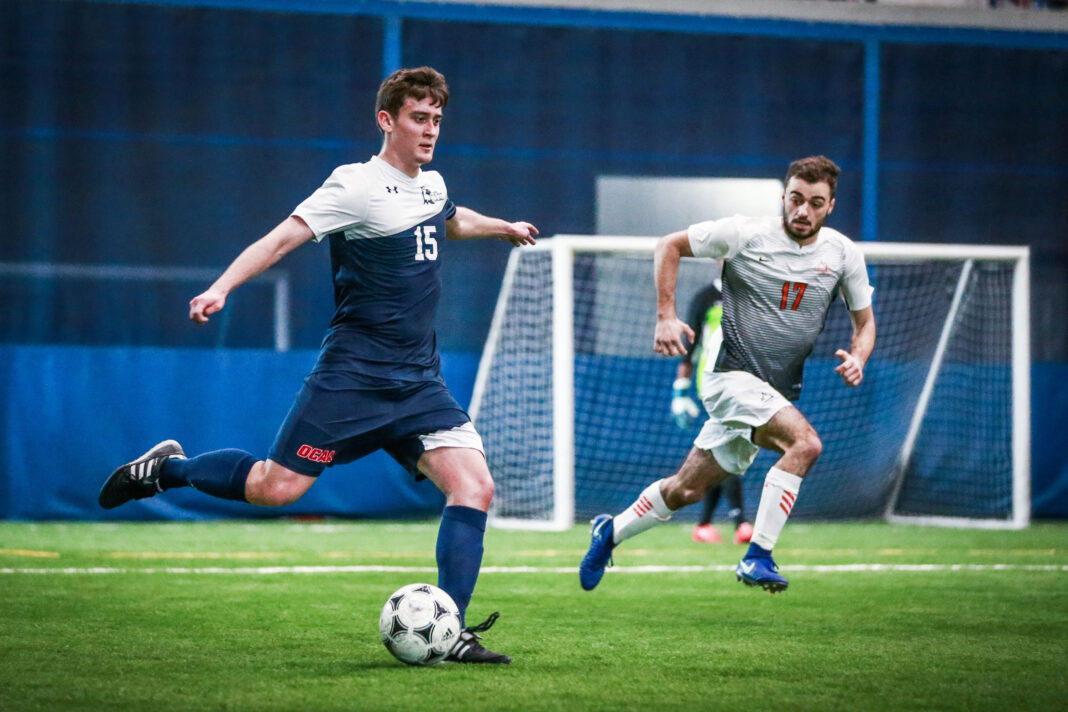By Rafael Indyarta
The OCAA is unique in that it offers two variations of the world’s most popular sport, indoor soccer and outdoor soccer. Indoor soccer is quite prevalent in Canada, seeing as a typical soccer pitch is covered in snow for half the year. It is a good way to keep those soccer muscles active, when its -30 outside.
Differences in the two sports lie in more than just where they are played. The size of the pitch, the specific rules, and even the cleats differ between outdoor and indoor soccer. The sizing alone results in multiple rule changes that make indoor soccer feel like a completely different sport. The pace of the game is quicker, and the tactics vary.

In the 2018/2019 season Humber won the OCAA indoor soccer championship, while Durham College won the outdoor championship, a real testament to the difference between the two sports.
The official size of an indoor field cannot exceed 65 metres in length or be smaller than 45 metres in length, with a width between 30 and 23.5 metres, while the typical outdoor pitch is 120 metres by 90 metres. The smaller pitch affects the number of players allowed on the field. The OCAA allows six players to be on the field at once, but different leagues will have different rules. Some leagues will allow up to eight, others may only allow five.
Indoor soccer also plays with a different time frame. The OCAA plays with two periods of 20 minutes, and there is only a 2-minute break in between periods. Some leagues may play for longer periods, and some even play in quarters.
Indoor soccer allows for unlimited substitutions, compared to outdoor soccer’s allowance of 3 substitutions. This leads to fresher bodies on the pitch, and more fast-paced action. The net in indoor soccer is also smaller. Players must be a lot more accurate when striking the ball. The official net size for the OCAA is 3.5 metres wide and 2 metres high.
There is also no offside, and no slide tackling. Defenders need to play with extra care, while attackers are given more freedom to move. Throw-ins are also not used in indoor soccer. Typically, in outdoor soccer, a throw-in is given when the goes out of play on the sideline, but in indoor soccer, those are replaced with free kicks. This is because some indoor facilities play with boards (like hockey), so there may not be room.
Cleats also differ between the two sports. Outdoor cleats have the typical studs you associate with soccer. Indoor cleats are designed with smaller studs to play on turf, so their studs are a lot smaller. You may even see cleats with flat bottom, typically used for hard floor surfaces.
The main tactical differences come from the rule variance. “The difference between the two is that you can play high-tempo, high pressure for an entire 40 minutes in indoor, whereas in [outdoor soccer] it’s impossible to do that,” Julian Carr, Centennial Indoor and Outdoor Men’s soccer coach said.
“You can run it like a hockey team… you can literally have guys out there for 45 seconds to a minute-and-a-half and just run them high tempo… you can run teams right off the park.”
Seneca Women’s Indoor Coach, Luca Sirianni, said that his preparations involve more speed training, compared to practice for outdoor soccer.
“Our training is more anaerobic in nature with more high intensity interval training requiring more sprinting over shorter distances,” Sirianni said.
“At the end of the day it is still soccer with the same objective although the formats differ.” Sirianni said. Coach Carr, on the other hand, finds that the indoor season prepares players for tight space play, but hinders players in other ways. “The big issue we have in Canada is that we spend so much of the time with our kids playing in small spaces, that when they go in a large space in an 11 v. 11, everything gets played short,” He said.
Coach Carr said that outdoor remains the more unpredictable of the two, because of the weather. “As soon as you add in the elements… it becomes about how tactically smart you are,” he said. “In indoor, it’s always dead wind, and the superior athletes and players will always win nine times out of ten.”

